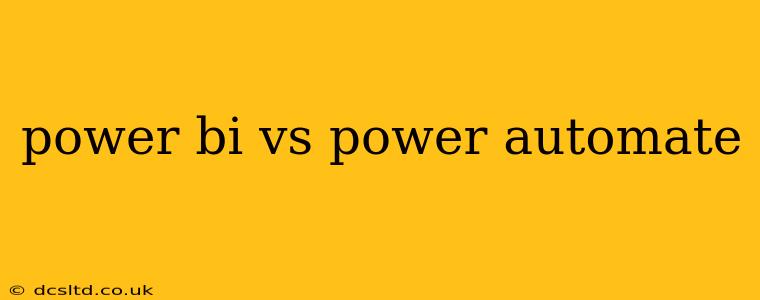Power BI and Power Automate are both powerful Microsoft tools within the Power Platform, but they serve very different purposes. Understanding their distinctions is crucial for leveraging their combined potential effectively. This article will explore their individual functionalities, highlight their key differences, and explain how they can work together seamlessly.
What is Power BI?
Power BI is a business analytics service that transforms your company data into interactive visuals. Think stunning dashboards, insightful reports, and key performance indicators (KPIs) – all designed to help you understand your data and make data-driven decisions. It connects to a wide variety of data sources, allowing you to consolidate information from disparate systems into a single, unified view. With Power BI, you can:
- Visualize data: Create interactive dashboards and reports with charts, graphs, and maps.
- Analyze data: Explore trends, identify patterns, and gain valuable insights.
- Share insights: Collaborate with colleagues and share your findings easily.
- Monitor KPIs: Track key performance indicators to monitor progress toward goals.
- Automate report generation: Schedule reports to be automatically generated and distributed.
What is Power Automate?
Power Automate, formerly known as Microsoft Flow, is a workflow automation service. It allows you to automate repetitive tasks and processes, streamlining workflows across various applications. Power Automate excels at connecting different systems and automating actions between them. You can use it to:
- Automate repetitive tasks: Eliminate manual work by automating processes like data entry, email management, and file transfers.
- Integrate applications: Connect different apps and services, such as Salesforce, SharePoint, and Outlook, to create automated workflows.
- Improve efficiency: Streamline processes and reduce manual errors.
- Create custom workflows: Design workflows tailored to your specific business needs.
- Trigger actions based on events: Automate responses to triggers, such as new email arrivals or updated data in a spreadsheet.
Power BI vs. Power Automate: Key Differences
| Feature | Power BI | Power Automate |
|---|---|---|
| Primary Function | Data visualization and analysis | Workflow automation |
| Output | Interactive dashboards, reports, KPIs | Automated actions, updated data, notifications |
| Focus | Understanding data, generating insights | Automating processes, improving efficiency |
| User Interaction | Primarily interactive, user-driven | Primarily automated, event-driven |
| Data Source | Wide variety of data sources | Wide variety of applications and services |
How do Power BI and Power Automate Work Together?
While distinct, Power BI and Power Automate are highly complementary. They can be combined to create powerful, automated data analysis and reporting systems. For example:
- Automated Data Refresh: Power Automate can be used to automatically refresh data sources in Power BI, ensuring your dashboards always display the latest information.
- Automated Report Distribution: Power Automate can schedule the distribution of Power BI reports to specific individuals or groups.
- Triggering Reports Based on Events: An event within another application (e.g., a new sales order in a CRM) can trigger a Power Automate flow that generates a Power BI report showing the impact of that order.
- Data Preparation and Cleaning: Power Automate can clean and prepare data before it’s imported into Power BI, improving the quality of your analyses.
What are the benefits of using both Power BI and Power Automate together?
Combining Power BI and Power Automate offers significant advantages, including:
- Increased Efficiency: Automate data processes and reporting, freeing up valuable time for more strategic tasks.
- Improved Accuracy: Reduce manual errors through automation.
- Better Decision-Making: Access up-to-date, accurate data for informed decisions.
- Enhanced Collaboration: Share insights and reports easily with colleagues.
- Data-Driven Culture: Foster a culture of data-driven decision-making.
Can I use Power BI without Power Automate?
Absolutely! Power BI is a standalone tool, capable of connecting to numerous data sources and providing valuable insights without the need for Power Automate. However, integrating Power Automate significantly enhances its capabilities.
Can I use Power Automate without Power BI?
Yes! Power Automate is entirely independent of Power BI and can be used to automate various processes without involving data visualization.
In conclusion, Power BI and Power Automate are distinct but synergistic tools. While Power BI focuses on data analysis and visualization, Power Automate excels at automating workflows. Using them together unlocks a powerful combination that can transform how your organization handles data and streamlines its operations.
